Text

October 31, 2022 - Micronesian Megapode (Megapodius laperouse) Found in the Northern Mariana Islands and Palau, these small megapodes live in forests, coconut groves, coastal scrub, and rocky areas. They eat spiders, insects, snails, seeds, small fruit, and other plant foods, foraging on the forest floor, usually in pairs. Depending on the subspecies, they nest in burrows or build mounds. Females dig the burrows in areas heated by the sun or geothermal sources, often near fallen or live trees. Both parents build the mound nests mostly from leaf litter and sand. They are classified as Near Threatened by the IUCN due mostly to habitat loss from sea level rise and forest clearance, human disturbance, and invasive species.
65 notes
·
View notes
Text
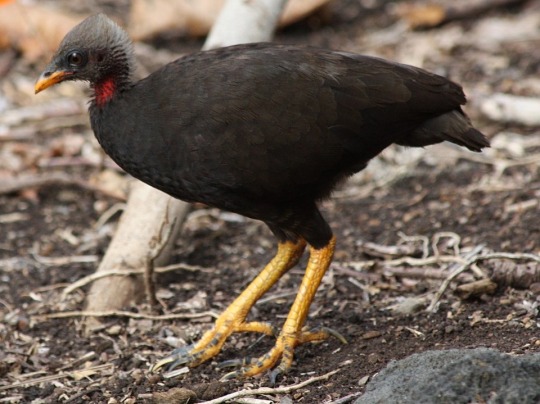
Range: Certain islands of the Northern Mariana Islands
#poll#Class: Aves#Order: Galliformes#Family: Megapodiidae#Genus: Megapodius#Megapodius Laperouse#Range: Australasian
21 notes
·
View notes
Text




208) Megapodius laperouse; nogal mikronezyjski, Micronesian megapode (megapod mikronezyjski), Micronesian scrubfowl (kurak zaroślowy mikronezyjski) - zagrożony gatunek megapoda, zamieszkujący wyspy zachodniego Oceanu Spokojnego.
Kurczak mikronezyjski (Megapodius laperouse) został nazwany na cześć francuskiego odkrywcy Jean-François de Galaup, hrabiego de Lapérouse.
Ptak ten nadal występuje na Marianach. Wcześniej odnotowano go na wyspach Asuncion, Agrihan, Pagan, Aguijan i Alamagan. Pozostała populacja kilku ptaków może przetrwać na Saipan i Tinian, a wyginął na Rota i Guam. Małe grupy ptaków często odwiedzają zarośla i zarośla niskich wysp peryferyjnych w regionie; jednak gdy występują na większych wyspach, można je również znaleźć w głębi lądu na wyższym terenie. Jego siedliskiem jest gęsty las, a on sam jest wszystkożerny, zjadając dużą różnorodność pokarmu z dna lasu.
Często nieśmiałe i skryte, ale stają się stosunkowo oswojone na zamieszkanych wyspach, gdzie są chronione przed zakłóceniami. Odwiedzają kopce lęgowe kilka razy dziennie. Wiadomo, że ptaki te skradają się w cieniu małych drzew i nie są w stanie latać na duże odległości. Są jednak znakomitymi biegaczami i byłoby je bardzo trudno złapać. Mikronezyjski kurak i niektóre inne megapody to jedyne ptaki, które wysiadują jaja, wykorzystując ciepło wulkaniczne.
W sezonie rozrodczym, zaraz po nadejściu południowo-wschodniego monsunu, samice tworzą duże kopce z gruzu, w których składają jaja. Niektóre pojedyncze samice składają jaja razem w tym samym kopcu. Jednak samice nie korzystają z tego samego kopca więcej niż raz i są zamieniane z innymi samicami. Kiedy jaja wyklują się po jednym do dwóch miesiącach, pisklęta będą żywić się pędami traw i owadami.
Gatunek ten jest obecnie klasyfikowany jako bliski zagrożenia, ponieważ ma bardzo mały zasięg, ograniczony do odizolowanych, niezakłóconych wysepek na morzu. Megapodius laperouse występuje na Palau i Marianach Północnych, a na Guam został wytępiony. Uważa się, że wprowadzenie psów, kotów, świń i szczurów doprowadziło do spadku liczebności tego gatunku na większości wysp. Wraz ze wzrostem drapieżnictwa, podczas japońskiej okupacji wysp Saipan i Tinian, większość roślinności obu wysp została spalona i zastąpiona dużymi farmami trzciny cukrowej. Szacuje się, że pozostało tylko 2000–2500 osobników gatunku. Można go znaleźć w państwie wyspiarskim Palau i niezakłóconych wyspach łańcucha Marianów Północnych, z kilkoma setkami na Sarigan. Podobno niedawno niewielka populacja została ponownie wprowadzona na Saipan. Ptak ten znajduje się w kategorii Czerwonej Listy IUCN z 2010 r. (według oceny BirdLife International — oficjalnej Czerwonej Listy dla ptaków IUCN). Gatunek ten kwalifikuje się jako „zagrożony”, ponieważ ma bardzo mały zasięg, ograniczony do odizolowanych, niezakłóconych wysepek na morzu, z niewielką liczbą ptaków w innych miejscach. Biorąc pod uwagę liczne zagrożenia w całym zasięgu, prawdopodobnie cierpi z powodu ciągłego spadku liczebności. Wydaje się, że jedynym sposobem na zapewnienie bezpieczeństwa gatunkowi jest ochrona kilku małych wysp i wypuszczenie tam niewielkiej populacji megapodów. W ten sposób zapewniona zostanie bezpieczna populacja. Na większych i wyższych wyspach wzrost liczby ludzi i wprowadzonych szkodników prędzej czy później zniszczy wszelkie populacje megapodów.
0 notes
Text
Megapodius

Orange-Footed Scrubfowl, M. reinwardt, by Bernard Dupont, CC BY-SA 2.0
PLEASE SUPPORT US ON PATREON. EACH and EVERY DONATION helps to keep this blog running! Any amount, even ONE DOLLAR is APPRECIATED! IF YOU ENJOY THIS CONTENT, please CONSIDER DONATING!
Name: Megapodius
Status: Extant
First Described: 1823
Described By: Gaimard
Classification: Dinosauria, Saurischia, Eusaurischia, Theropoda, Neotheropoda, Averostra, Tetanurae, Orionides, Avetheropoda, Coelurosauria, Tyrannoraptora, Maniraptoriformes, Maniraptora, Pennaraptora, Paraves, Eumaniraptora, Averaptora, Avialae, Euavialae, Avebrevicauda, Pygostylia, Ornithothoraces, Euornithes, Ornithuromorpha, Ornithurae, Neornithes, Neognathae, Galloanserae, Pangalliformes, Galliformes, Megapodiidae
Referred Species: M. pritchardii (Tongan Megapode, Extant), M. laperouse (Micronesian Megapode, Extant), M. nicobariensis (Nicobar Megapode, Extant), M. cumingii (Philippine Megapode, Extant), M. bernsteinii (Sula Megapode, Extant), M. tenimberensis (Tanimbar Megapode, Extant), M. freycinet (Dusky Megapode, Extant), M. geelvinkianus (Biak Scrubfowl, Extant), M. eremita (Melanesian Megapode, Extant), M. layardi (Vanuatu Megapode, Extant), M. affinis (New Guinea Scrubfowl, Extant), M. reinwardt (Orange-Footed Scrubfowl, Extant), M. molistructor (Pile-Builder Scrubfowl, Extinct), M. amissus (Viti Levu Scrubfowl, Extinct)

Micronesian Megapode, M. laperouse, by Michael Lusk, CC BY-SA 2.0
Megapodius is, by far, the largest genus of Megapodes, with many species making up its genus. Most of these species are alive today, though there are two distinct extinct ones as well. These birds are commonly called Scrubfowl, and, like all Megapodes, are distinctly unique due to their highly specialized method of egg incubation. M. molistructor, the Pile-Builder Megapode, is an extinct species from New Caledonia and Tonga, known from only about 12,000 years ago on, in the Holocene of the Quaternary. Weighing about 3.5 kilograms, it was the heaviest species in this genus, and one of the largest ground-dwelling birds of the islands it lived on. This bird probably went extinct due to the arrival of human settlers about 3500 years ago. The other extinct Speices, M. amissus, the Viti Levu Scrubfowl, was a Megapode known from Fiji during the Holocene, about the size of the Orange-Footed Scrubfowl, though with more robust legs and reduced wings, indicating flightlessness. It, too, went extinct due to overhunting and other human activity.
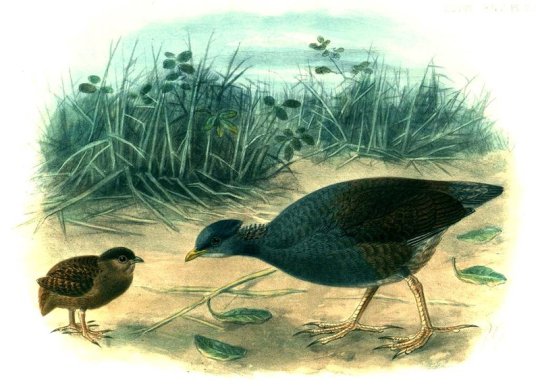
Tongan Megapode, M. pritchardii, by Walter Lawry Buller, in the Public Domain
The Tongan Megapode is an endangered species known from Tonga, the only remaining species of Megapode still known from these islands, even though multiple species were present prior to the arrival of humans. Their remote habitat made populations of these birds vulnerable to human activity. They live primarily in tropical lowland forests, and they use the warm volcanic soil of their habitats to incubate their eggs. The baby birds are able to fly immediately upon hatching. These birds are threatened due to human hunting and habitat reduction.
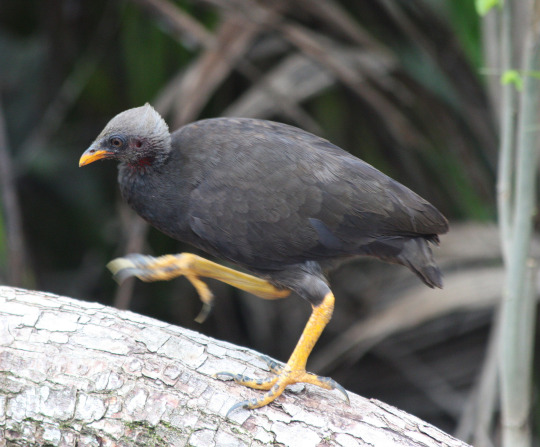
Micronesian Megapode, M. laperouse, by Michael Lusk, CC BY-SA 2.0
The Micronesian Megapode is another endangered species, about 38 centimeters in length, from the Marianas Islands. Medium-sized birds, they have pale heads, dark bodies, and bright yellow legs. They are usually found in thickets and lowland scrub, and they’re very shy and secretive. They breed after the monsoon season and make large mounds of debris to lay their eggs, sometimes multiple females using the same mound. They are protected, but the introduction of mammalian predators have greatly reduced their populations.
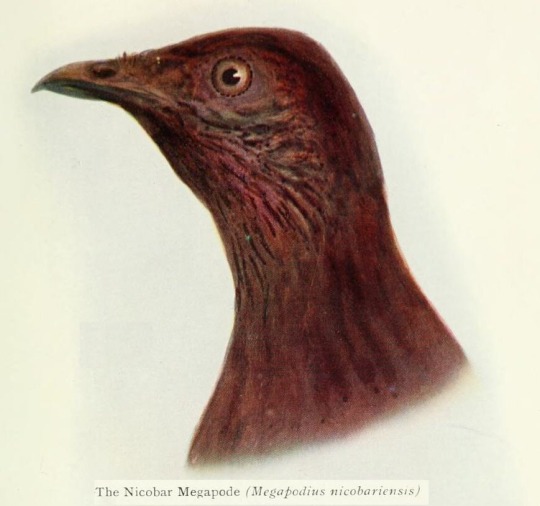
Nicobar Megapode, M. nicobariensis, by R. W. Shufeldt, in the Public Domain
The Nicobar Megapode is a vulnerable species known from the Nicobar Islands of India. It builds large nest mounds, like the other species in this genus; but are very secretive in how they do so - they primarily build mounds near the coast with coral sand and plant material, and the mounds are often reused. The young birds are fully feathered, and can fly as soon as their feathers dry up. They mainly move around in thick jungle during the day, and go out onto the shore of the ocean at night, mainly walking in small groups or pairs. They eat both plant and animal material, ingesting grit to aid in digestion. They are brownish birds, and are primarily threatened due to habitat loss and human activity.

Philippine Megapode, M. cumingii, by Jason Thompson, CC BY 2.0
The Philippine Megapode, which is such a little cutie, is a non-threatened species found in the Philippines, Borneo, and Sulawesi, mainly in dry forest, moist lowland forest, and mountain forests.

Sula Megapode, M. bernsteinii, by Huub Veldhuijzen van Zanten, CC BY-SA 3.0
The Sula Megapode, is a vulnerable species known on the Banggai and Sula Islands in Indonesia, primarily in tropical and subtropical forest, both dry and wet, as well as mangrove forests. As such, it is extensively threatened with habitat destruction. These birds are reddish brown, with short pointed crests, and they grow up to 35 centimeters in length. They forage in pairs, or sometimes small groups, mainly on roots and invertebrates. They perform mating dances, to an extent, where all the birds call out together, and then build cone-shape mounds over rotting vegetation to keep the eggs warm. The Tanimbar Megapode, M. tenimberensis, on the other hand, is a near-threatened species from the Tanimbar Islands of Indonesia, about the size of a domestic chicken. It’s primarily found in forest and scrubland, and feeds on fallen fruit, seeds, and invertebrates.

Dusky Megapode, M. freycinet, by Nicolas Huet, in the Public Domain
The Dusky Megapode, is a 41 centimeters long black bird with a short pointed crest and red facial skin. They look similar across the sexes, and build mounds made of leaves, sand, gravel, and sticks, as large as 11 meters in diameter. They are very common birds and not considered currently threatened with extinction.
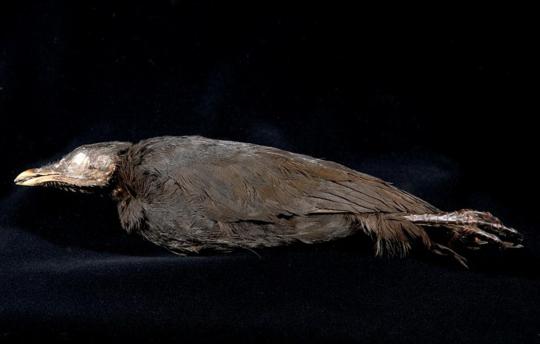
Biak Scrubfowl, M. geelvinkianus, by Huub Veldhuijzen van Zanten, CC BY-SA 3.0
The Biak Scrubfowl is a vulnerable species known from islands in West Papua, Indonesia, measuring about 36 centimeters in length, with dark grey feathers and a blueish face. They live in lowland tropical forests and some shrublands, which has lead to its threatened position due to habitat loss.
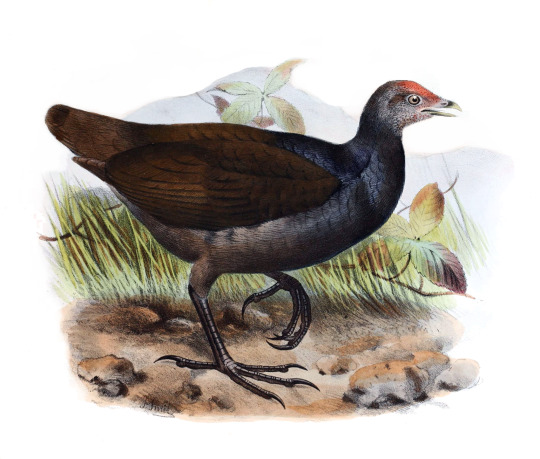
Melanesian Megapode, M. eremita, by Joseph Smit, in the Public Domain
The Melanesian Megapode is a nonthreatened scrubfowl species from Papua New Guinea and the Solomon Islands, living in tropical lowland forests and some mountain forests. It has brown and blue feathers, and a red patch on its head.

Vanuatu Megapode, M. layardi, by W. R. Ogilvie-Grant, in the Public Domain
The Vanuatu Megapode is a vulnerable species known from the island of Vanuatu, living in subtropical and tropical lowland forest. Unfortunately, it’s threatened by habitat loss and egg hunting. The New Guinea Scrubfowl, N. decollatus, on the other hands, is a poorly studied nonthreatened Megapode from tropical lowland forests and mountain forests in New Guinea, but unfortunately it isn’t very well documented.
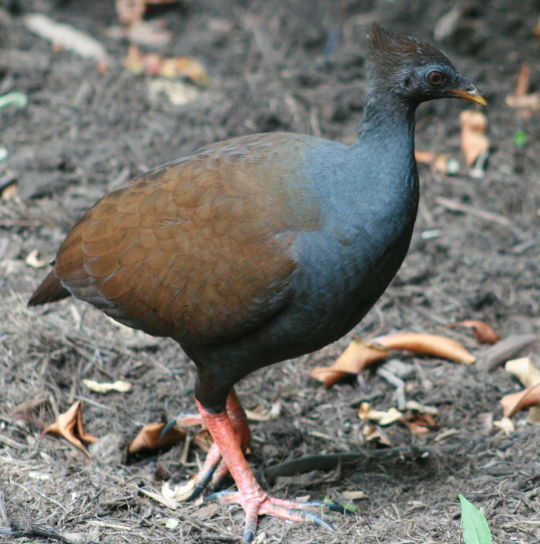
Orange-Footed Scrubfowl, M. reinwardt, by Toby Hudson, CC BY-SA 3.0
Finally, the Orange-Footed Scrubfowl is a non-threatened species from the Sunda Islands, New Guinea, and Australia. The size of a chicken, it has brown and blue feathers, with orange feet, hence its name. They also have distinctive pointy crests. They live in forest and scrubland habitat, and make mounds of sand and leaf litter that can reach up to 4.5 meters in height. They mainly eat seeds, fallen fruit, and some invertebrates.
Buy the author a coffee: http://ko-fi.com/kulindadromeus
Sources:
https://en.wikipedia.org/wiki/Scrubfowl
https://en.wikipedia.org/wiki/Pile-builder_megapode
https://en.wikipedia.org/wiki/Viti_Levu_scrubfowl
https://en.wikipedia.org/wiki/Tongan_megapode
https://en.wikipedia.org/wiki/Micronesian_megapode
https://en.wikipedia.org/wiki/Nicobar_megapode
https://en.wikipedia.org/wiki/Philippine_megapode
https://en.wikipedia.org/wiki/Sula_megapode
https://en.wikipedia.org/wiki/Tanimbar_megapode
https://en.wikipedia.org/wiki/Dusky_megapode
https://en.wikipedia.org/wiki/Biak_scrubfowl
https://en.wikipedia.org/wiki/Melanesian_megapode
https://en.wikipedia.org/wiki/Vanuatu_megapode
https://en.wikipedia.org/wiki/New_Guinea_scrubfowl
https://en.wikipedia.org/wiki/Orange-footed_scrubfowl
#megapodius#scrubfowl#megapode#dinosaur#chicken#pheasant#birblr#palaeoblr#megapodius pritchardii#tongan megapode#megapodius laperouse#micronesian megapode#megapodius nicobariensis#nicobar megapode#megapodius cumingii#philippine megapode#megapodius bernsteinii#sula megapode#megapodius tenimberensis#tanimbar megapode#megapodius freycinet#dusky megapode#megapodius geelvinkianus#biak scrubfowl#megapodius eremita#melanesian megapode#megapodius layardi#vanuatu megapode#megapodius affinis#new guinea scrubfowl
45 notes
·
View notes
Photo

Camping in Paradise With the total collapse of mass tourism, Palau’s formerly crowded beaches have been transformed into tranquil retreats. Ngermeaus Beach is now an eco-paradise, where Megapodes roam and sharks rule. Our 2022 safari season delivered action packed days and star filled nights. What will the future hold for this pristine tropical gem? Photos by Ron Leidich #palau #paddlingpalau #kororpalau #micronesia #micronesian #safari #camping #campingsafari #campinglife #campingtrip #kayakadventures #kayaklife #kayaks #kayaking #kayakingadventures #kayak #photooftheday #photogram #photodaily #photoeveryday #photography #photos (at Palau Micronesia) https://www.instagram.com/p/CeCnuCshAWv/?igshid=NGJjMDIxMWI=
#palau#paddlingpalau#kororpalau#micronesia#micronesian#safari#camping#campingsafari#campinglife#campingtrip#kayakadventures#kayaklife#kayaks#kayaking#kayakingadventures#kayak#photooftheday#photogram#photodaily#photoeveryday#photography#photos
0 notes
Photo

Micronesian Megapode (Megapodius laperouse), Photo by Michael Lusk.
Scientific American: "Micronesian megapodes are the only birds known to incubate their eggs using the heat from volcanoes. "
11 notes
·
View notes
Note
One of the rarest birds I've seen in person is the Micronesian Megapode. I would be super curious to find out if anyone else following this has seen one! Any chance it could be added to the queue? Thanks!
Queued! I would love to see one of those <3, absolutely amazing you were able to see one!!
16 notes
·
View notes
Photo

Rock Island Animal Rescue: This unfortunate Collared Kingfisher fell victim to a clever Indo-Pacific Tree. Local hunters call this tree species Uudeuidarbekai because the sticky glue on the seeds, gets caught on the feet of Micronesian Megapodes (Bekai). The tree is known scientifically as Pisonia umbellifera or simply "The Bird Catching Tree." The plant spreads its seeds through the forest using a powerful adhesive which ensnares the bird's feathers. If the bird dies as a result, it simply supplies more fertilizer for the developing seeds. The tenacious seeds may even ensnare small reptiles and insects. Nature rarely intervenes, but in 2019 a group of visiting students from Redlands University, helped save the young kingfisher from a gruesome fate. By applying coconut oil, the students removed all of the seed pods before setting the feathered patient back into the forest. Watch where you step... it's a jungle out there! . . . Photo by Ron Leidich, Elilai Sugiyama, Shane Keena . . . #palau #paddlingpalau #bird #birding #micronesia #kingfisher #fun #explore #wanderlust #wanderer #wander #photooftheday #photo #photographer #photography #photoshoot #birdrescue (at Palau) https://www.instagram.com/p/CN1XgZzhxLi/?igshid=e1isgdezsfpv
#palau#paddlingpalau#bird#birding#micronesia#kingfisher#fun#explore#wanderlust#wanderer#wander#photooftheday#photo#photographer#photography#photoshoot#birdrescue
0 notes